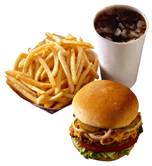
MONDAY, March 30, 2015 (HealthDay News) — American children are getting fewer calories a day from fast food restaurants, but one-third still eat ready-to-go pizza, chicken and burgers on a daily basis, a new study finds.
Among kids aged 4 to 19, national health and nutrition surveys showed that average daily calorie consumption from fast food restaurants fell by 110 calories between 2003 and 2010, said study author Colin Rehm. Also, the percentage of kids consuming fast food on a given day dropped from nearly 39 percent to about 33 percent in the period, the McDonald’s-funded study found.
“It is good news with a few important qualifiers,” said Rehm, who worked on the research while at the University of Washington. “We need to make sure that the decrease in calories hasn’t been paralleled by a drop in nutrients or food groups.”
The findings suggest young people are consuming fewer high-calorie foods and beverages at burger restaurants during their visits, Rehm said, while making fewer visits to pizza places and eating smaller portions of pizza when they do. (The percentage of kids who got food at pizza joints fell from 12 percent to 6 percent, the study said.)
“We observed a decrease in calories for burger, pizza and chicken restaurants,” said Rehm, now a nutrition scientist at Tufts University in Boston. “We did not observe any changes for sandwich or Mexican restaurants.”
Kids’ eating habits are of concern because in the past three decades obesity has more than doubled in children and quadrupled in adolescents, according to the U.S. Centers for Disease Control and Prevention.
Rehm believes the results suggest that fast-food restaurants are serving healthier options.
Another expert said parents may also be getting the message that fast food is generally unhealthy.
“Studies that have looked at the nutrition quality of fast food have shown that most of the options available are poor quality,” said Kelly Purtell, an assistant professor of human sciences at Ohio State University.
“Fast food meals are often deficient in important nutrients and contain high levels of added sugars and fats, so reductions in overall caloric intake are likely a good sign,” she said.
“The proliferation of alternative restaurants with relatively fast service are also potentially contributing to the reductions,” Purtell said.
Does the study point to a healthier trend? Purtell thinks so, although she acknowledged that kids could be eating fewer calories and less nutritious food.
“It is also important to note that over 30 percent of kids report eating fast food in a given day. This is still incredibly high,” Purtell added.
She said the new study is important because it helps researchers understand trends in fast food consumption among kids.
“We have known that kids eat a lot of fast food, but this provides new information,” she said.
The reported decline in calories from fast food parallels research on U.S. adults that showed that overall calories from fast food fell from 13 percent in 2007-2008 to 11 percent in 2009-2010, according to background notes with the study.
For kids, the statistics suggest that total calories consumed fell by about 205 calories a day from 2003-2010, Rehm said. “About half of this drop was due to decreases in calories from fast food, he said.
The findings appear in a research letter published March 30 in JAMA Pediatrics.
The study authors launched their research to gain understanding of how fast food consumption by kids might be changing. “We also wanted to examine, for the first time, trends in fast food consumption by type of fast food restaurant,” Rehm said.
He noted that the surveys should have picked up visits to newly popular “fast casual” restaurants like Chipotle and Panera Bread because they qualify as fast food restaurants.
Whether calorie information on menus has had an effect isn’t known. Rehm said calorie information wasn’t required in many places in the United States during the period of the study.
Purtell thinks they can be helpful, however. While teens don’t seem affected much by calorie counts on menus at fast-food places, she said “there is some evidence that parents may order lower-calorie meals for their children if they have this information.”
More information
For more about children’s nutrition, see the American Academy of Pediatrics.
Copyright © 2025 HealthDay. All rights reserved.

